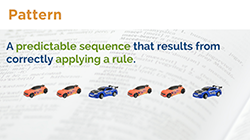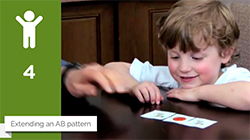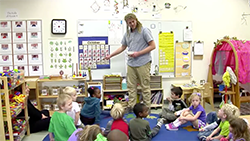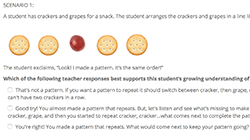STEP Learning Modules
Organization and Design
STEP is organized into six learning modules. The first module provides an introduction that gets learners familiar with the overall goals, frame, and big ideas of the learning experience. The remaining five modules are focused on the areas of early mathematics - Numeracy, Operations, Geometry and Spatial Sense, Patterning, Measurement. Within each module, 30-minute sessions explore a particular skill, and how that skill is inter-connected with one or more executive function (EF) skills.
STEP learning modules are designed to be complemented by the STEP coaching process but can also be used on their own for more traditional online learning approaches. The learning modules give participants many opportunities to see what early mathematics and EF look like, engage in interactive activities to solidify their understanding of new content, and discuss ideas with peers. The modules are also designed to grab the learner's attention, be relevant to preschool teachers, and provide opportunities for practice so that teachers build confidence and feel successful.
Intro to STEP
Numeracy
Operations
Geometry and Spatial Sense
Patterning
Measurement
The Session Flow
Each session is about 30 minutes long, with chunked bite-sized video lessons that address different topics and strategies along the way.
1. What is it?
The session always starts out with an introduction to each skill. The focus is not only on explaining the skill but also why it's relevant and what it looks like in the context of preschool classrooms. For example, an introduction to the skill, duplicating, extending, and creating patterns, helps learners understand what types of patterns preschoolers are typically working on, as well as the idea that patterns are not just visual, but also auditory and kinesthetic.

2. How it Develops
Once learners understand what the skill is, they get a sense of how it develops in young children from birth to age five. Learners get to see children display their skills in action at different stages of development. A particular emphasis is placed on the preschool years, from ages 3 to 5.

3. Targeted Strategies
Each session provides one to three targeted strategies that support a child's growth in a particular mathematics skill. Teachers are not only introduced to steps or best practices in these lessons, but they get a chance to watch different teachers implement them in the classroom.

4. You Try It
Each session provides several opportunities for learners to check their knowledge and understanding. Short "Check Your Knowledge" questions are embedded throughout the session. In addition, one longer interactive exercise encourages learners to watch a classroom scenario and identify relevant math strategies. Some exercises also address common misconceptions about a particular skill.

5. Throughout the Day and Beyond
Learners get a chance to see ways math can be incorporated throughout the day. This gives teachers ideas for integrating math moments into daily routines, such as lunch time, snack, transitions, or outside play.

6. Math and Executive Function
For each skill, learners get a chance to see how one or more of the three EF skills - inhibitory control, working memory, and cognitive flexibility- are related to children's developing mathematics abilities. It allows learners to see how mathematics and EF skills work together, as well as how teachers can intentionally design mathematics activities that support growth in both areas.

7. Making a Plan!
All of the sessions include the option for teachers to either select their own mathematics activity, or choose one that we have provided. If teachers choose their own lesson, they are provided with a template that helps them to think through how they will incorporate the strategies they have learned into their activity.

